A Negro Boy Held by Phineas Carl
 In 1797 Willet Seaman received news of an enslaved man, about thirty years old, who had repeatedly claimed to have been born free before being taken from his mother as a young child and sold into slavery. He was sold several times thereafter as well, making it more and more difficult to construct a sense of his past. The letter repeatedly references that the man’s owner was refusing to provide evidence that the enslaved man was indeed legally a slave, even though most agreed that he was only a “bound child,” or apprentice, yet still a free-born person. The letter closes by stating the agonizing fact that while the consensus opinion agreed he was free, the enslaved man was still being held in bondage since he could not prove the abduction that had happened when he was a two-year old child. As you read this plea for assistance, consider the different legal standards for freedom and slavery that are being employed in this case.
In 1797 Willet Seaman received news of an enslaved man, about thirty years old, who had repeatedly claimed to have been born free before being taken from his mother as a young child and sold into slavery. He was sold several times thereafter as well, making it more and more difficult to construct a sense of his past. The letter repeatedly references that the man’s owner was refusing to provide evidence that the enslaved man was indeed legally a slave, even though most agreed that he was only a “bound child,” or apprentice, yet still a free-born person. The letter closes by stating the agonizing fact that while the consensus opinion agreed he was free, the enslaved man was still being held in bondage since he could not prove the abduction that had happened when he was a two-year old child. As you read this plea for assistance, consider the different legal standards for freedom and slavery that are being employed in this case.
Questions:
-
What factors did this enslaved individual have to contend against to prove his freedom, even though most agreed that he had been born free?
-
Though this plea is written from a compassionate ally, what is the chief grievance that it lists? Does it match up with our modern sense of the wrongs done to this young man?
